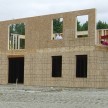How To Frame Window Openings
Framing Window Openings
 One of the most basic framing techniques involves framing window and door openings. Understanding the anatomy of a framed window opening will help you properly frame both window and door rough openings.
One of the most basic framing techniques involves framing window and door openings. Understanding the anatomy of a framed window opening will help you properly frame both window and door rough openings.
The adjacent diagram shows a traditionally framed window opening from a recent project. Each of the major components are labeled and described below. It’s worth pointing out that this wall is on the gable side of the building which means there are very minimal vertical loads, hence the small window header.
Window Framing Components
- Double Top Plate – Double top plates are almost always used in today’s modern framing. The double top plate helps evenly distribute the load to the studs below.
- Cripple – Window and door cripples are studs that fill the space above a header and below a sill.
- Header – Headers are a load bearing beam that transfers the load above the opening down to the jacks. Sizes of headers depend on structural loading and capacity.
- King Jack – The King Jack runs adjacent to the jack stud from top plate down to the bottom plate.
- Jack Stud – The Jack Stud transfers the load from the header down to the bottom plate. Depending on the size of the opening a window or door can have a few as one jack stud on either side or multiple jack studs with large openings that carry higher loads.
- Sill – The window sill (sometimes called a saddle) creates the bottom of the window rough opening. The sill varies from single piece to a double piece as shown in this photo. Many builders will use a double sill to improve the width of nailing surface for the window flanges.
- Cripple
- Bottom Plate – The bottom plate is a single piece of framing material that transfers the stud loads down to the foundation.
Doors are framed in the same way as the window shown above without the lower sill and cripples. Obviously there are some small differences depending on local building codes and regional preferences. If you want to learn more about framing a building then I recommend you check out this Book On Framing.


















this was very informative thank you
how do you decide the size of the header as we are building a PWF basement and are trying to make sure our windows will be more then adequate. if there is no reply that is fine this information is lots to start with
thank you again
Matt – Header size depends on many factors including floor and roof loading from above depending on how the building is framed. Headers can range from 6 inches in depth from dimensional lumber all the way up to 12 or more inches with engineered lumber. In most cases your local lumber yard or code official can help with that. Good luck.
Very educating subject I really appreciate it.
Thank you very much
If my window is 18×24 do I make the rough frame exactly that size?
No sir….you need to make it larger in order to shim the window.
How much larger based on the aforementioned window dimensuons?
Thank you Todd, Checking out your info. has helped me to not make 1 crucial mistake. I wouldn’t have known to install a double header plate in my garage addition. Always great to get the facts straight from a fellow New Hampshire neighbor.-Don
Thank you. A quick concise synopsis of some basic terms. I appreciated the simple article.
Very informative. As a full time carpenter myself, my only suggestion would be to change the short studs above the lintel to below the lintel, and push the lintel all the way to the underside of the top plate. This is not a necessary detail and does not affect the structural nature of a lintel, but if for any reason the window size is desired to be taller after the fact, the renovation process is much simpler.
I am having a concrete block house built, and i didn’t see any framing dimensions for block walls with windows. My openings are about 44″ x 64″. What size window will go in this opening, and are they going to build an extra wood frame first to go in this opening?
You need to have an RO big enough to put a wood “buck” in first, then install the window.
Do I need a lintel if I am using shingles and a hip roof design. Total load transferred down to the walls is conservatively at 200 plf will the double top plate serve as my lintel
You def need a lintel
Todd,
Thank you for the article on framing. It is very informative. I would like to ask a question?
I have a patio that measures 17’4” Is it possible to put 2 60” RO windows and a 72” sliding patio door in this wall? If so how could I frame this? The patio was open and had a 17’4” X 10’ Hip roof (12” overhang) over it Supported by 2 decorative 4” posts on the outside and attached and framed into the house on the back side.
Enough information without being too much dribble it was brilliantly put them full but very very very informative educational. I’m not showing anything I’m just trying to the first time and when custom designing rooms around rental houses trying to understand what’s internal without known what’s internal but this is very professional and at the same time very very simple understand terms and why